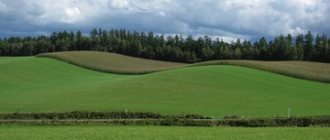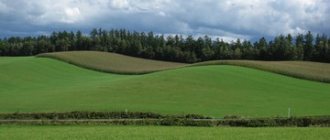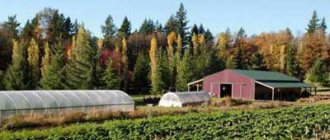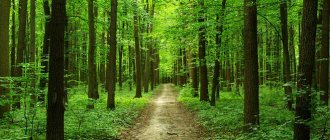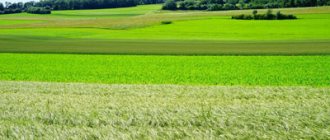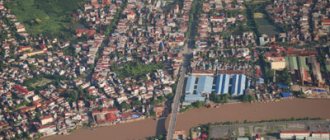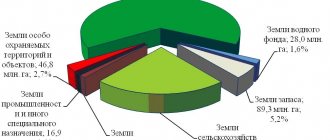Home / Real estate / Land / Categories of land plots
Back
Published: 11/02/2017
Reading time: 10 min
0
840
Forest plot is a land plot located within the boundaries of forest districts/forest parks and formed in accordance with the requirements of land legislation and the Forest Code.
- Rights to plots
- VRI for these lands
- Amnesty of forest areas
- Construction Who can apply for land transfer?
Legislation on forest resources
Forest fund lands are a special category of land, which is regulated by the Forest Code and the Land Code.
The forest fund includes areas covered with shrubs, trees and grass or not covered with forest vegetation (but intended for forest restoration in the future), as well as areas used for forestry and located within the forest fund.
The forest fund includes areas of non-forest and forest. It includes areas without vegetation, in particular:
- with felling - on which stumps remain;
- with young forest;
- with burnt and dead trees;
- with clearings and free from forest;
- with open spaces: isolated trees.
The Forest Fund includes all forests, except for forests in areas for defense purposes (used by the armed forces) and settlement lands.
They are indicated on maps with special signs.
Rights to plots
According to the Constitution, the forest fund of Russia is jointly owned by the Russian Federation and the constituent entities of the federation. If a forest plot is located in areas of defense significance, then only the federation can be the owner.
Forest fund lands are prohibited from being used in free circulation: sales and purchase agreements are not allowed in relation to them and they cannot be the subject of a pledge.
At the same time, the legislation allows the transfer of such lands for the use of individuals and legal entities under agreements:
- rent;
- free use;
- concessions;
- short-term use.
Russians can freely use these lands to satisfy their needs: picking mushrooms and berries, hunting and fishing.
Citizens can restrict access to forest areas only in the event of life-threatening situations: for example, in the event of a forest fire or a threat to environmental safety.
Classification
Such lands are divided according to the classes of characteristics of the forests that grow on them, as well as according to the intended use of the forests:
- Operational and reserve forests that are not included in other categories. Defined as "valuable forests".
- Forests located in specially protected natural areas and can be adjacent to specially protected lands, changing their category.
- Forests located in water protection zones.
- Forests that perform the functions of protecting natural and other objects, including especially protected areas.
Reference: Protective forests are those used as water protection, sanitary and hygienic, health-improving environments and protective strips adjacent to protected objects.
VRI for these lands
Article 25 of the Forest Code identifies the following types of permitted exploitation of lands from the forest fund:
- harvesting of wood, resin, non-timber forest resources, food forest resources, medicinal plants;
- hunting farm;
- agricultural management;
- research and educational activities in the field of forestry;
- recreational activity;
- growing forest plantations;
- growing seedlings, berries, fruits and ornamental plants;
- geological research work;
- construction of reservoirs, linear facilities, wood processing;
- religious activity.
What zones are distinguished by types and monitoring results?
Monitoring of these lands is a comprehensive process aimed at improving environmental protection measures. Comprises:
- observations;
- analysis and evaluation;
- forecasts for the development of the monitoring zone.
The selection of zones for monitoring is made according to the following indicators:
- studying the danger of forest fires;
- study and assessment of forest resources;
- study and assessment of lands included in the forest fund;
- study of underdeveloped areas;
- analysis of received information for international programs and agreements.
Based on the analysis, the following are distinguished:
- risk areas;
- high efficiency zones;
- areas requiring further study;
- exploitation zones;
- reserve zones.
Risk zones are identified based on increased fire hazard and can be divided into risk classes. Efficiency zones are adjacent to the definition of exploitation zones and reserve zones. Lands where logging and other types of use are currently permitted that do not reduce the quality of the forest are considered suitable for exploitation. In reserve zones, logging is not allowed for the next twenty years.
To differentiate efficiency zones, a classification of efficiency of use is provided. Underdeveloped areas are distributed according to the priority of development of certain areas. Based on the totality of monitoring goals, it is necessary to use the zoning principle rather conditionally, in combination with other principles and approaches.
Particular attention is paid to the study of the ecological state of forests and adjacent areas:
- mutual influence of neighboring ecosystems on each other;
- the need to intervene in ongoing natural processes;
- efficiency of ecosystem use.
Based on the data obtained as a result of monitoring, the resource is managed. Arrays are selected for cutting down, or restoration, for transfer to other categories.
Amnesty of forest areas
In July 2021, the State Duma adopted in its final reading a bill called the Forest Amnesty.
This law should solve the acute problem of illegal construction in disputed territories.
What do legislators understand by “disputed territories”?
Currently, the USRN and the Forest Register contain many intersections. According to the first register, this land belongs to areas on which the construction of housing and their transfer to private ownership are permitted. Whereas the Forest Register does not allow such use of the land included in its composition.
What is the essence of the Forest Amnesty?
She assumes that all controversial situations should be interpreted in favor of the Unified State Register of Real Estate. This means that all cases of use of lands from the forest fund registered in the cadastral register are declared legal starting this year.
The law refers to huge areas: in the Moscow region alone, the disputed territory includes over 185 hectares of land allocated for dacha or private development.
The forest amnesty has many advantages. Finally, it will resolve lengthy litigation to determine the categories of land plots. The law will also solve the problem of thousands of Russians who, by mistake of cadastral engineers, were allocated plots for dacha construction from forest fund lands. As a result, they had difficulty legitimizing the buildings. An amnesty will allow such citizens to secure property rights for themselves.
The adoption of the forest amnesty law had many opponents. They fear that the priority of the Unified State Register of Real Estate will lead to a massive withdrawal of land from the forest fund and the destruction of a huge tract of Russian forest. It is assumed that the forest amnesty will lead to mass construction in forests in areas of large cities.
Thus, according to ecologists, the forest fund may be reduced by 1.7-4 hectares, which has very negative environmental consequences.
The law also equalizes the rights of those who unwittingly became the owner of a plot in the forest fund and those who seized this land by criminal means as a result of the use of fraudulent schemes.
Both of them, as a result of using the implemented legal norms, will be able to become full owners of forest areas.
Kinds
Due to the special functions of a natural and economic nature for the country’s economy, these lands are part of:
- State Land Fund.
- State Forest Fund.
Some areas belong to both the state land and forest funds. In some cases, areas covered with forest are not included in the forest fund, belonging to other categories of land plots (LP):
- recreational lands;
- environmental protection zones;
- protective strips, etc.
The forest fund also includes areas not covered with trees, which are called non-forest lands.
In general, the forest fund is divided into types.
Forest districts and forest parks
The forest fund includes forest districts and forest parks. Only certain types of work are allowed here that allow for the extraction of benefits from natural forest resources, including their authorized cutting. With the permission of federal and municipal authorities, it is allowed to organize recreation areas for citizens of the locality. In accordance with the regulations of the legislation, forest infrastructure is being developed (Part 6 of Article 21 of the RF LC).
This category is distinguished by the presence of deciduous and coniferous tree species. Tree species occupy about 99% of the total area. In addition, there are free areas here that are not covered with trees and shrubs, but provision is made for their planting and forestation. Or - the plants died as a result of fire and other natural disasters, but it is planned to restore the territory by saving the remaining objects and planting new ones.
Their list is as follows:
- felling;
- burning;
- natural and artificial clearings;
- clearings.
Non-forest areas
These include areas where trees and shrubs do not grow directly . They include the location of other natural objects that are not included in the forest area, but intersperse it or are located in the forest growing area:
- meadows, forest edges, marshy areas;
- rivers crossing the forest area;
- lakes and other water sources;
- rocky areas and roads.
They are included in the established category, belonging to the corresponding cadastral quarter, from where they cannot be arbitrarily withdrawn. And also taking into account the fact that without them the forest as an ecosystem cannot exist, since it consists of closed and non-closed areas of forest crops.
Construction
Construction work is allowed on forest lands. But you cannot build a private house on them. The legislation allows the construction of the following types of buildings in forest areas:
- gatehouses and other buildings of this kind;
- tourist camps;
- physical education complexes;
- health resorts.
Private buildings are allowed to be erected only on the lands of populated areas and agricultural lands. At the same time, development of forest fund lands was often carried out due to an unclear division of lands into categories.
Transfer to settlement lands
The transfer of forest fund lands to the land of populated areas may be required if it is necessary to carry out construction work on the lands or use them for other purposes not provided for by the current edition of the Land Code.
Also, a plot of land from the Forest Fund cannot be registered as a property until it is excluded from the forest register.
Such transfer to the land of a populated area is carried out in exceptional situations and this procedure requires a special procedure.
Thus, according to current legislation, such a translation is permitted in the following cases:
- when such a change is provided for by forest management documentation/territorial planning documentation;
- when the features of settlements change;
- in order to create protected areas, classify lands as historical, cultural, environmental zones;
- if there is no need for land management in forestry;
- if it is impossible to further use the land for its intended purpose;
- when there is a need for land for defense purposes, etc.
Checking out of an apartment and registering in another can be quite simple; you need to collect the necessary package of documents and contact the relevant authorities. How long will a large family have to wait to receive the treasured land? Find out about this from our article.
Do you dream of getting a plot of land for farming? Here are step-by-step instructions on how to achieve your goal as quickly as possible.
Concept and general characteristics
Forest fund lands include areas of land covered with forests or intended for afforestation. A forest is understood as a natural economic object and a specific ecological system consisting of a growth of tree species and shrubs. A forest plot, according to Article 27 of the Land Code of the Russian Federation, is a type of land plot.
Forest zones can be of natural (natural) or artificial origin, which does not make any difference between their status and belonging to the designated Fund. The forest is also considered a valuable state resource, which is governed by federal legislation.
The main sources of legislation that determine the legal regime of lands are Article 101 of the Land Code of the Russian Federation, the “Forest Code of the Russian Federation” (LC RF), adopted on December 4, 2006 under No. 200-FZ and the Decree of the Government of the Russian Federation of September 23, 2010 No. 736 “On the Federal forestry agency.
These lands are on the state balance, in federal ownership. Can be transferred to municipalities on the basis of permanent (indefinite) use. They are subject to cadastral registration and are not objects of land real estate. Forest management is carried out by the state. All legal actions must be authorized by Government orders and be guided by the basic norms of Article 1 of the Land Code of the Russian Federation.
Important! Lease for a period of 10 to 49 years is allowed, provided that it is used for its intended purpose.
For the use of the massif, security and protective measures, for the reproduction of forest plantations, regulations for the creation of forest infrastructure are provided:
- forest roads;
- timber warehouses;
- facilities for processing harvested wood.
These objects, after completion of the relevant work, are subject to demolition, and the forest lands where they were previously erected are subject to reclamation. Forest roads are an exception and may continue to function.
